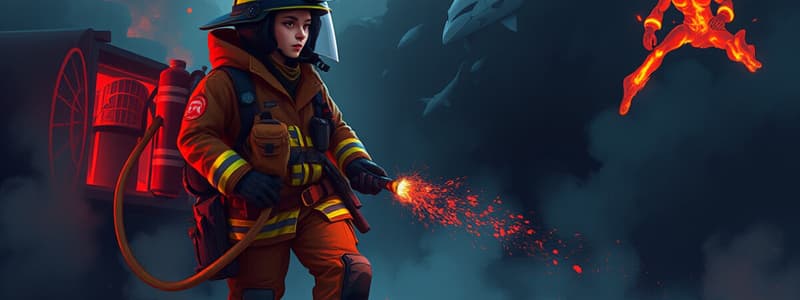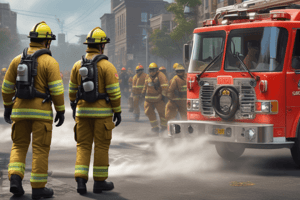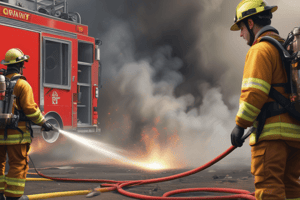Podcast
Questions and Answers
What is crucial for the Incident Safety Officer (ISO) in ensuring firefighter safety?
What is crucial for the Incident Safety Officer (ISO) in ensuring firefighter safety?
- Presenting concerns in a manner that appeals to the incident commander. (correct)
- Focusing solely on enforcing rules without collaboration.
- Making unilateral decisions without considering input from the IC.
- Extensively documenting every safety concern before addressing it.
How can safety triggers be categorized?
How can safety triggers be categorized?
- Only passive methods.
- Active and passive options. (correct)
- Proactive and inactive measures.
- Only active or reactive options.
What is an example of an active safety trigger?
What is an example of an active safety trigger?
- Performing regular safety drills.
- Distributing safety flyers to the team.
- Firm intervention to correct unsafe behavior. (correct)
- Wearing a high-visibility vest.
Which statement best describes the role of the ISO in relation to the Incident Action Plan (IAP)?
Which statement best describes the role of the ISO in relation to the Incident Action Plan (IAP)?
What effect does being visible as an ISO have on the firefighters?
What effect does being visible as an ISO have on the firefighters?
What is NOT considered a benefit of using various safety triggers?
What is NOT considered a benefit of using various safety triggers?
What is a subtle method of triggering safety awareness?
What is a subtle method of triggering safety awareness?
Which approach should the ISO take when addressing issues with the Incident Commander?
Which approach should the ISO take when addressing issues with the Incident Commander?
Which of the following is NOT recommended for ISOs to effectively set a good example?
Which of the following is NOT recommended for ISOs to effectively set a good example?
What is the primary purpose of using humor as a soft intervention?
What is the primary purpose of using humor as a soft intervention?
What does the bunker cop syndrome primarily focus on?
What does the bunker cop syndrome primarily focus on?
Which of the following best describes an imminent threat?
Which of the following best describes an imminent threat?
Which action is considered a firm intervention?
Which action is considered a firm intervention?
What should ISOs do when they evaluate their own environment and exposure?
What should ISOs do when they evaluate their own environment and exposure?
What is a consequence of the CYA mode for an ISO?
What is a consequence of the CYA mode for an ISO?
Which of the following is a characteristic of potential threats that may require soft intervention?
Which of the following is a characteristic of potential threats that may require soft intervention?
What is an effective way for ISOs to communicate in a large incident?
What is an effective way for ISOs to communicate in a large incident?
What is a sign of an ISO falling into bunker cop syndrome?
What is a sign of an ISO falling into bunker cop syndrome?
In what situation should soft interventions be avoided?
In what situation should soft interventions be avoided?
Which of the following approaches is important for ISOs to avoid in their interventions?
Which of the following approaches is important for ISOs to avoid in their interventions?
What actions should ISOs take when entering an IDLH environment?
What actions should ISOs take when entering an IDLH environment?
What is the primary focus of the Incident Safety Officer (ISO) during an incident?
What is the primary focus of the Incident Safety Officer (ISO) during an incident?
What should the ISO do if there are too few personnel to complete assigned tasks?
What should the ISO do if there are too few personnel to complete assigned tasks?
How should the ISO communicate significant safety messages?
How should the ISO communicate significant safety messages?
Which of the following best describes the relationship between the Incident Commander (IC) and the ISO?
Which of the following best describes the relationship between the Incident Commander (IC) and the ISO?
What is the preferred method of communication between the ISO and the IC?
What is the preferred method of communication between the ISO and the IC?
What is a critical responsibility of the ISO during a complex incident?
What is a critical responsibility of the ISO during a complex incident?
What does DTRT stand for in the context of firefighter safety?
What does DTRT stand for in the context of firefighter safety?
When discussing problem-solving with the IC, the ISO should present which of the following?
When discussing problem-solving with the IC, the ISO should present which of the following?
What is the primary purpose of a formal written Incident Action Plan (IAP)?
What is the primary purpose of a formal written Incident Action Plan (IAP)?
What is meant by the term 'solution orientation' in the context of an IC?
What is meant by the term 'solution orientation' in the context of an IC?
In which situation should an ISO call for an ASO from command?
In which situation should an ISO call for an ASO from command?
How often should the ISO communicate with the IC during an incident?
How often should the ISO communicate with the IC during an incident?
Which communication barrier indicator suggests there is too much communication?
Which communication barrier indicator suggests there is too much communication?
What does the ISO need to yield to the authority of the IC?
What does the ISO need to yield to the authority of the IC?
Which incidents necessitate the appointment of an Incident Safety Officer with specialized training?
Which incidents necessitate the appointment of an Incident Safety Officer with specialized training?
What is a crucial step when transferring the ISO function from one individual to another?
What is a crucial step when transferring the ISO function from one individual to another?
Which characteristic is NOT associated with Type 1 incidents?
Which characteristic is NOT associated with Type 1 incidents?
During an emergency incident, what does the ISO rely on line safety officers (SOFRs) to do?
During an emergency incident, what does the ISO rely on line safety officers (SOFRs) to do?
What does the acronym MEDIC stand for in the context of transferring ISO responsibilities?
What does the acronym MEDIC stand for in the context of transferring ISO responsibilities?
What primary role does the ISO assume during Type 1 or Type 2 incidents?
What primary role does the ISO assume during Type 1 or Type 2 incidents?
Which condition is NOT appropriate for prompting the transfer of an ISO?
Which condition is NOT appropriate for prompting the transfer of an ISO?
Which of the following represents a passive trigger for safe behaviors initiated by the ISO?
Which of the following represents a passive trigger for safe behaviors initiated by the ISO?
Which statement about the NIMS Integration Center is incorrect?
Which statement about the NIMS Integration Center is incorrect?
What is NOT a critical element to be included in the Incident Action Plan (IAP)?
What is NOT a critical element to be included in the Incident Action Plan (IAP)?
What is one responsibility of the ISO during multi-agency incidents using unified command?
What is one responsibility of the ISO during multi-agency incidents using unified command?
What is a primary function of the ISO in relation to safety measures at the incident site?
What is a primary function of the ISO in relation to safety measures at the incident site?
Which term best describes the situation where an ISO must initiate a firm intervention?
Which term best describes the situation where an ISO must initiate a firm intervention?
What should be considered when creating an effective IAP for an incident?
What should be considered when creating an effective IAP for an incident?
What is the primary communication method the ISO should use when coordinating with the IC?
What is the primary communication method the ISO should use when coordinating with the IC?
Under what circumstances would it be appropriate for an ISO to request additional Safety Officers (ASOs)?
Under what circumstances would it be appropriate for an ISO to request additional Safety Officers (ASOs)?
What acronym should an ISO remember to communicate essential information when transferring duties?
What acronym should an ISO remember to communicate essential information when transferring duties?
What functional identifier should the designated ISO use when communicating via radio?
What functional identifier should the designated ISO use when communicating via radio?
Which of the following types of incidents is categorized as Type 2?
Which of the following types of incidents is categorized as Type 2?
What should the ISO do if communication barriers are detected during radio transmissions?
What should the ISO do if communication barriers are detected during radio transmissions?
Why might an ISO need to transfer their duties to another individual?
Why might an ISO need to transfer their duties to another individual?
What is a common reason for barriers in communication during an incident?
What is a common reason for barriers in communication during an incident?
How often should the ISO meet with the IC during typical incidents?
How often should the ISO meet with the IC during typical incidents?
What should an ISO include in their three statements and a question when addressing the IC?
What should an ISO include in their three statements and a question when addressing the IC?
Flashcards are hidden until you start studying
Study Notes
Introduction to Safety Messaging
- Successful Incident Safety Officers (ISOs) utilize a variety of communication methods to enhance safety awareness among crews.
- ISO effectiveness hinges on how concerns and solutions are presented to the Incident Commander (IC), maintaining harmony is crucial for firefighter safety.
Safety Triggers
- Training officers emphasize the motto, "Train like we play and play like we train," to promote safe behaviors during incidents.
- ISOs must use various triggers to instill situational awareness among firefighters, categorized as passive (subtle) and active (direct).
- Examples of passive triggers include visibility and setting an example, while active triggers encompass soft and firm interventions.
Being Visible
- ISOs should wear a high-visibility vest marked "SAFETY," promoting self-correction among crews and enhancing their visibility.
- The National Fire Protection Association (NFPA) mandates that safety officers be easily identifiable during incidents for effective communication.
- A distinctive vest color, preferred as green, helps crews recognize hazards and promotes hazard sharing with ISOs.
Setting an Example
- ISOs influence crew behavior through personal accountability, adherence to safety protocols, and visible self-discipline.
- Guideline adherence includes staying in sight of responders and using personal protective equipment (PPE).
Soft Intervention
- Safety issues may require soft interventions that are non-confrontational and promote awareness without immediate urgency.
- Effective techniques include using humor, subtle reminders, and asking non-threatening questions to encourage safer practices.
- Soft interventions are inappropriate during imminent threat scenarios; maintaining relevance is key to successful communication.
Firm Intervention
- Firm interventions entail direct orders to stop or modify unsafe actions, with authority supported by the IC.
- NFPA standards grant ISOs the power to halt activities posing imminent threats, necessitating immediate communication to the IC post-intervention.
ISO Traps
- Bunker Cop Syndrome: Focusing excessively on PPE inspection, risking broader safety oversight.
- CYA Mode: Prioritizing personal liability over crew safety, leading to distrust from firefighting teams.
- Worker Trap: Becoming overly involved in tactical tasks, impairing the ISO's observational role.
Working Within Command Systems
- ISOs operate within the Incident Command System (ICS), reporting directly to the IC and supporting safety function.
- The ISO-IC relationship is strengthened through proper authority, communication, and solution-oriented approaches.
ISO's Role with Incident Action Plans (IAPs)
- The ISO must confirm the IAP upon assignment, focusing on responder safety objectives and necessary updates.
- Written IAPs are required for complex incidents, including specific safety forms like ICS 208 and ICS 215A.
Local-Level ISO Function Expansion
- Request for additional safety officer resources may arise under certain conditions, including large geographic incidents or increased risk scenarios.
- Well-trained ASOs may be necessary for specialized incidents, such as hazardous materials and technical rescues.
Transferring ISO Responsibilities
- ISO duties may shift due to incident complexity or operational requirements. A formal briefing using the MEDIC acronym ensures continuity of safety oversight.
National Incident Management System (NIMS)
- NIMS provides structure for complex incident responses, categorizing incidents from local Type 5 events to federal Type 1 events.
- Incident management timelines dictate ISO transition from tactical observations to strategic planning as incident scale increases.
Summary of ISO Functionality
- ISOs enact safety behavior through a combination of passive and active triggers, tailoring interventions based on the immediacy of threats.
- Effective ISOs should avoid the traps of excessive oversight, self-preservation, and tactical involvement to sustain their effectiveness in enhancing firefighter safety.### NFPA Standards and NIMS Integration
- The Incident Safety Officer (ISO) is part of the command staff, directly reporting to the Incident Commander (IC).
- Elements in the Incident Action Plan (IAP) include strategic goals, risk-taking levels, tactical assignments, incident priorities, communication channels, and safety concerns.
ISO Responsibilities
- The ISO emphasizes risk management and safety hazards in monitoring incidents.
- Firm interventions by the ISO (e.g., stop, alter, suspend) must be communicated to the IC to ensure appropriate IAP adjustments.
- Radio communication is vital for fast reporting of interventions to avoid delays.
Communication Protocols
- Face-to-face meetings with the IC are required every 15 minutes during typical incidents.
- The ISO should primarily use radio communication for firm interventions, identifying themselves as “Safety” rather than their usual identifier (e.g., Battalion 101).
- The ISO must monitor radio transmissions for communication barriers, which may result from equipment problems, human errors, or administrative controls.
Problem-Solving Approach
- The ISO should adopt a solution-oriented communication style with the IC, including:
- Observations: "This is what I see."
- Interpretations: "This is what it means to me."
- Recommendations: "Here’s my solution."
- Inquiries: "What do you think?"
Requesting Additional Support
- The ISO can expand safety resources by requesting Assistant Safety Officers (ASOs) through the IC when incidents are complex or large.
- Circumstances for requesting ASOs may include geographic size, risk levels, activation of Rapid Intervention Crews (RIC), or multi-agency involvement.
Transfer of ISO Duties
- ISO responsibilities may be handed off for several reasons, such as:
- Need for higher expertise.
- ISO fatigue or multiple operational periods.
- The ISO's focus shift to the role of an ASO.
- Transitioning the incident to another agency or Incident Management Team (IMT).
- The MEDIC acronym helps with transferring duties, ensuring all key information is shared:
- Monitoring issues.
- Evaluating known hazards.
- Developing preventive measures.
- Documenting interventions.
- Communicating any issues.
Incident Typing Scheme
- Incident types are categorized by resource requirements:
- Type 5 = Local incidents easily managed.
- Type 4 = Local incidents needing extra resources.
- Type 3 = Regional incidents.
- Type 2 = Multiregional or state incidents needing fewer than 200 personnel.
- Type 1 = Most complex incidents.
- Types 1 and 2 incidents typically have organized Incident Management Teams (IMTs) ready to respond.
ISO Function and Field Safety
- The ISO role is filled by Safety Officer 1 (SOF1) or Safety Officer 2 (SOF2), who may assign Line Safety Officers (SOFRs) to help with field safety functions.
Studying That Suits You
Use AI to generate personalized quizzes and flashcards to suit your learning preferences.




